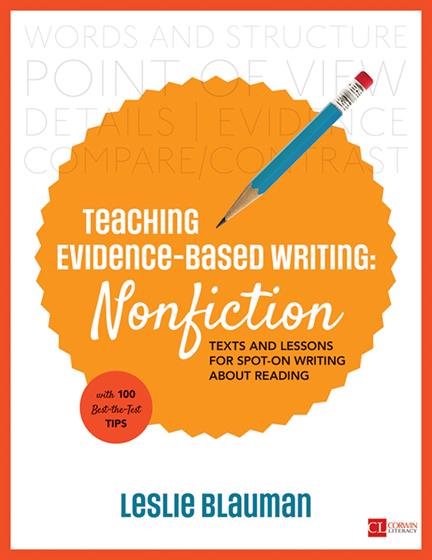VIDEO CLIPS
WRITE-ABOUT-READING TEMPLATES
EXCERPTS TO WRITE ABOUT
DYNAMIC DUOS: ADDITIONAL IDEAS FOR TEACHING WITH THE TEXTS
ACKNOWLEDGMENTS
INTRODUCTION
Section 1. Evidence
Lesson 1. Ask and Answer Questions
Write-About-Reading Template: Ask and Answer Questions
Excerpt to Write About: “Where Do Tornadoes Come From?” From How Come? Every Kid’s Science Questions Explained by Kathy Wollard
Lesson 2. Cite Evidence
Write-About-Reading Template: Prove It!
Excerpt to Write About: “The Storm Factory” From Hurricane Force: In the Path of America’s Deadliest Storms by Joseph B. Treaster
Lesson 3. Use Quotes to Summarize Text
Write-About-Reading Template: Build My Summary
Excerpt to Write About: “Saving Cheetahs” by Suzanne Zimbler
Lesson 4. Cite and Analyze
Write-About-Reading Template: Analyze and Cite Evidence
Excerpt to Write About: “The Computer” From What a Great Idea! Inventions That Changed the World by Stephen M. Tomecek
Section 2. Relationships
Lesson 5. Explain Events, Procedures, or Concepts
Write-About-Reading Template: Important Events and Ideas
Excerpts to Write About: “Enemy at the Gates” From Science Warriors: The Battle Against Invasive Species by Sneed B. Collard III
Lesson 6. Analyze How Authors Introduce, Illustrate, and Elaborate
Write-About-Reading Template: Introduce, Illustrate, and Elaborate
Excerpts to Write About: Albert Einstein Biographies: Odd Boy Out: Young Albert Einstein by Don Brown; On a Beam of Light: A Story of Albert Einstein by Jennifer Berne; Who Was Albert Einstein? by Jess Brallier; Giants of Science: Albert Einstein by Kathl
Lesson 7. Describe Relationships and Interactions
Write-About-Reading Template: It’s All About Connections
Excerpt to Write About: “Opening Doors for Others” From Jackie Robinson: Strong Inside and Out by Denise Lewis Patrick
Lesson 8. Analyze the Connections Between People, Events, and Ideas
Write-About-Reading Template: Events, Individuals, and Ideas: How Do They Influence?
Excerpts to Write About: Influential Speeches: “The Gettysburg Address” by Abraham Lincoln; “I Have a Dream” Speech by Martin Luther King, Jr.
Section 3. Main Idea/Central Idea
Lesson 9. Identify Main Idea and Details
Write-About-Reading Template: Main Idea
Excerpts to Write About: “A Hurricane Arrives” From Violent Skies: Hurricanes by Chris Oxlade
Lesson 10. Understand Topics and Subtopics
Write-About-Reading Template: Topic Sentences
Excerpts to Write About: “White Death” From Avalanche! The Deadly Slide by Jane Duden
Lesson 11. Determine Central Ideas: Details
Write-About-Reading Template: Think About the Central Idea
Excerpt to Write About: “How Does a Chameleon Change Its Color?” From How Come? Planet Earth by Kathy Wollard
Lesson 12. Determine Multiple Ideas in a Text
Write-About-Reading Template: State the Central Idea
Excerpt to Write About: Years of Dust: The Story of the Dust Bowl by Albert Marrin
Section 4. Point of View
Lesson 13. What Is the Author’s Purpose?
Write-About-Reading Template: Author’s Point of View
Excerpt to Write About: Foreword by Jane Goodall From Untamed: The Wild Life of Jane Goodall by Anita Silvey
Lesson 14. Determine Author’s Purpose and Point of View
Write-About-Reading Template: Notice Perspective
Excerpts to Write About: “Students Lead the Way” and “Retaliation and Intimidation” From The Split History of the Civil Rights Movement by Nadia Higgins
Lesson 15. Compare and Contrast Accounts
Write-About-Reading Template: Analyze Firsthand and Secondhand Accounts
Excerpts to Write About: Freedom’s Children: Young Civil Rights Activists Tell Their Own Stories by Ellen Levine
Lesson 16. Explore Same Topic, Many Points of View
Write-About-Reading Template: Analyze Different Perspectives
Excerpts to Write About: Rosa Parks: Rosa by Nikki Giovanni; Rosa Parks: Civil Rights Pioneer by Karen Kelleher; Rosa Parks: My Story by Rosa Parks with Jim Haskins
Section 5. Visuals
Lesson 17. Mine Maps, Charts, and Other Visuals
Write-About-Reading Template: Visuals + Text = Better Understanding
Excerpt to Write About: “A Hot Topic” From Everything Volcanoes and Earthquakes by Kathy Furgang
Lesson 18. Read Digital and Print Efficiently
Write-About-Reading Template: On the Search!
Excerpt to Write About: “Drought in the Plains” From The Dust Bowl by Rebecca Langston-George
Section 6. Words and Structure
Lesson 19. Determine the Meaning of Specialized Words
Write-About-Reading Templates: Word Attack!; What Does This Word Mean?
Excerpt to Write About: Weather! by Rebecca Rupp
Lesson 20. Spot Words That Signal Text Structure
Write-About-Reading Template: Dig Into the Structure of the Text
Excerpt to Write About: “Death Valley’s Super Bloom” by Kio Herrera
Lesson 21. Identify Text Structure
Write-About-Reading Templates: Look at Structure Across a Text (for Use With Short Texts); Look at Structure Across a Text (for Grades 6–8)
Excerpts to Write About: Volcano Facts: “What Is a Volcano?” From Violent Volcanoes by Louise and Richard Spilsbury; Volcanoes by Seymour Simon; “The Volcano Wakes” From Volcano: The Eruption and Healing of Mount St. Helens by Patricia Lauber
Lesson 22. Compare and Contrast Overall Structure of Two or More Texts
Write-About-Reading Template: Compare and Contrast Text Structure
Excerpts to Write About: The Hindenburg Disaster: What Was the Hindenburg? by Janet B. Pascal; You Wouldn’t Want to Be on the Hindenburg! A Transatlantic Trip You’d Rather Skip by Ian Graham
Lesson 23. Evaluate the Reasoning, Relevance, and Sufficiency of Evidence
Write-About-Reading Template: Author’s Point
Excerpt to Write About: “How Octopuses Change Color” From The Octopus Scientists: Exploring the Mind of a Mollusk by Sy Montgomery
Lesson 24. Delineate the Argument and Specific Claims
Write-About-Reading Template: Map the Argument
Excerpts to Write About: Fatal Fever: Tracking Down Typhoid Mary by Gail Jarrow
REFERENCES



